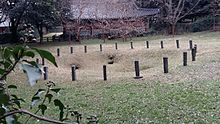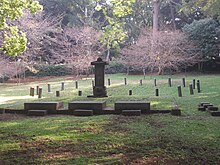Samseonghyeol
You can help expand this article with text translated from the corresponding article in Korean. (May 2021) Click [show] for important translation instructions.
|
| Samseonghyeol | |
 The three depressions in the ground (2016) | |
| Korean name | |
|---|---|
| Hangul | 삼성혈 |
| Hanja | |
| Revised Romanization | Samseonghyeol |
| McCune–Reischauer | Samsŏnghyŏl |
The Samseonghyeol (Korean: 삼성혈; lit. three clans' holes) is an archeological, historical, and cultural landmark in Jeju City, Jeju Province, South Korea.
It is associated with a Jeju founding legend. It is believed that three demigods emerged from the holes in the ground on this site, and became the first people of the island.
Information[edit]
The site is located in the city center of Jeju City and consists mainly of a shrine and a depression from which,[1] according to legend, three demigods emerged from the ground to become the founding fathers of the ancient kingdom of Tamna and its people.[2] Three families (or clans) bear the name and claim descendance from those deities.[1]
- Go Eulna (고을나; 高乙那; Ko Ŭlna)[1]
- Ryang Eulna (양을나; 良乙那; Ryang Ŭlna)[1]
- Bu Eulna (부을나; 夫乙那; Pu Ŭlna)[1]
The Legend of the Eulna[edit]
The myth states that in the beginning, there were no people in Tamna. According to old records (Goryeosa, Yeongjuji), there first was a strangely outstanding mountain called Hallasan. The clouds and the sea were clearly visible far above and below, and Hallasan, the main mountain, cast out three gods at a place called 'Moheung' at the northern foot of the island.[2] This was about 4,300 years ago, and the place is now called Samseonghyeol (三姓穴) because of the Samshinin (三神人) that came out (湧出).[citation needed] These deities were called Eulna. They were the founders of the three surnames, and they founded the kingdom of Tamna.[2]

The deities' shapes were very tall and large, giving them the appearance of immortals not found in human society.[citation needed] These three gods wore leather clothes and lived a primitive hunting life. One day, they climbed Hallasan and looked at the far eastern sea, where they saw a wooden box sealed with purple soil coming up along with the waves. Following the wooden chest, they arrived at the seashore of Onpyeong-ri, Seongsan-eup, and opened the wooden chest. There was a round jade box the shape of an egg inside, and a messenger wearing a purple robe.[2]
When the deities opened the jade box, three virgins, elegantly dressed in blue clothes with beautiful purple hues came out. They sat down together and brought cattle and five-grain seeds out on the coastal hill of Yeonhonpo.[2]
Accordingly, the three gods carefully prepared offerings, performed rites, and announced to the heavens that they would marry each of the three princesses. They set up a bridal chamber in a cave next to the pond, and lived from then on as human beings.[2]
References[edit]
- ^ a b c d e 현, 용준, "삼성혈 (三姓穴)", Encyclopedia of Korean Culture (in Korean), Academy of Korean Studies, retrieved 2024-06-18
- ^ a b c d e f 현, 용준, "삼성 신화 (三姓 神話)", Encyclopedia of Korean Culture (in Korean), Academy of Korean Studies, retrieved 2024-06-18
External links[edit]
- Samseonghyeol (English)
- Naver Encyclopedia Samseonghyeol [三姓穴 (Korean Folk Beliefs Dictionary: Village Faith Edition, 2009. 11. 12.)]
